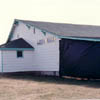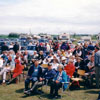Leisure and Recreation
 For much of the 20th century, Linda Hall was the premier venue for Estonian get-togethers and cultural events in the area south of Stettler. The idea for a community centre stemmed from a shared interest in creating a space where Estonian settlers could host social activities and political fora and share agricultural knowledge with one another. At a 1910 general meeting at the John Neithal home, several Estonian pioneers formed Linda Eesti Pôllumeeste Selts (Linda Estonian Agriculture Society). John Neithal was elected president and John Kerbes secretary while John Oro served as treasurer. Soon, 35 men became members. Naturally, the farmhouses became too small to host such large gatherings, and the idea of a community hall would soon become a reality.
For much of the 20th century, Linda Hall was the premier venue for Estonian get-togethers and cultural events in the area south of Stettler. The idea for a community centre stemmed from a shared interest in creating a space where Estonian settlers could host social activities and political fora and share agricultural knowledge with one another. At a 1910 general meeting at the John Neithal home, several Estonian pioneers formed Linda Eesti Pôllumeeste Selts (Linda Estonian Agriculture Society). John Neithal was elected president and John Kerbes secretary while John Oro served as treasurer. Soon, 35 men became members. Naturally, the farmhouses became too small to host such large gatherings, and the idea of a community hall would soon become a reality.
The term Linda is derived from the Estonian epic Kalevipoeg. Kalev was the protagonist in the story-complete with superhero powers-and Linda was his supportive and caring mother. Linda exuded intellectual traits and a love for Estonian culture. Members of Stettler's Estonian community recognized the correlation between the hall's objectives and the cultural values Linda embodied. Consequently, the community centre was appropriately named Linda Hall. Kalev's relevance in Estonian culture was not forgotten as the settlement northwest of Big Valley was dubbed Kalev.
The land for Linda Hall, located 11 miles south and 2 miles east of Stettler, was donated by Johannes Kerbes. To raise funds, box lunches were sold at local picnics, in turn raising over $300. Members of the Linda Estonian Agricultural Society also donated funds in equal amount. The hall was a modest rectangular building, positioned lengthwise from west to east. The west entrance doors opened directly into the spacious hall and faced the stage at the opposite end. Exclusive volunteer labour was used in building the structure and, on Jaanipäev 1911, members of the community officially opened the hall.
Inside the hall, furniture consisted of homemade benches and wooden tables. A large bookcase featuring various works about history, science, travel, and economics stood impressively in the corner. Over time, the collection expanded to over 200 titles; often people would drop by to borrow a book, thereby turning the hall into an impromptu library. The hall also featured an upright piano and was lit using oil lamps perched in the rafters. Tragically, a blazing fire in 1930 destroyed the facility and its collection of books.
 Community spirit remained high as donations soon trickled through and volunteers reconvened to build a new structure within the next few years. Activities and meetings were conducted in Estonian until the 1950s when a gradual switch to English became necessary due to the increased presence of the younger generation. Five or six large events were planned each year, including a fall masquerade, Christmas, Easter, Mother's Day, Father's Day and Jaanipäev. During the warm summer months, picnics were held outdoors adjacent to Linda Hall. Sports, speeches, and plays would often accompany a jovial picnic.
Community spirit remained high as donations soon trickled through and volunteers reconvened to build a new structure within the next few years. Activities and meetings were conducted in Estonian until the 1950s when a gradual switch to English became necessary due to the increased presence of the younger generation. Five or six large events were planned each year, including a fall masquerade, Christmas, Easter, Mother's Day, Father's Day and Jaanipäev. During the warm summer months, picnics were held outdoors adjacent to Linda Hall. Sports, speeches, and plays would often accompany a jovial picnic.
In 1925, the women living in the Linda Hall district formed a club of their own, known as Linda Naiste Rahvaste Ühisus (Linda Women's Society). Dozens of women attending functions conducted in Estonian also maintained close relations with the United Farmers of Alberta Women's Association. The club formally dissolved in the 1940s; however, many former members remained active in the community. In 1952, Anna Tipman, Salme Hennel, Dulcie Hennel, Dorthea Laing, and Doris Hennel established the Linda Hall Ladies Club with business conducted in English. Over the years, the men's and ladies' clubs cooperated in numerous joint financial ventures. With support from government grants, they were able to make considerable upgrades to Linda Hall. A kitchen was built along with the installation of electricity, forced air heating, and running water.
Since 1911, Linda Hall has hosted a plethora of community events, including meetings, concerts, dances, and weddings, among others. In 1999, Linda Hall was the site of the Alberta Estonian Centennial celebration, the largest gathering of Estonians in Alberta's history. Province-wide Jaanipäev celebrations have been held here, including the inaugural Alberta Estonian Heritage Society's Jaanipäev celebration in 2005. The history of the Linda Hall is an invaluable resource demonstrating Estonian camaraderie and the importance of community-based initiatives.








